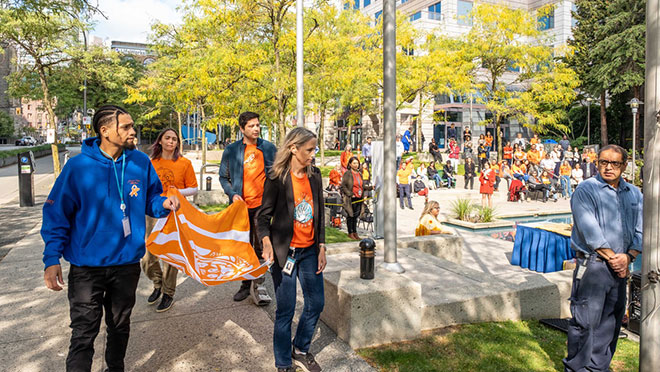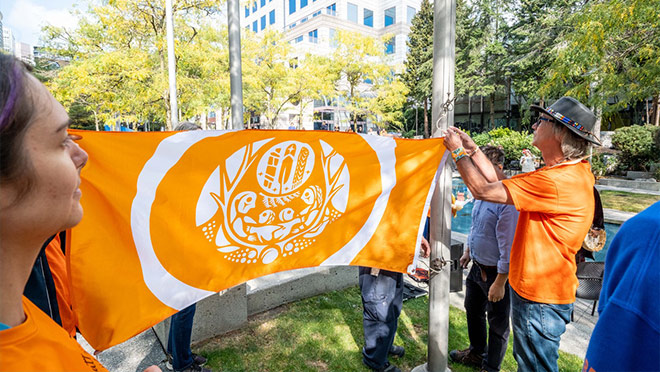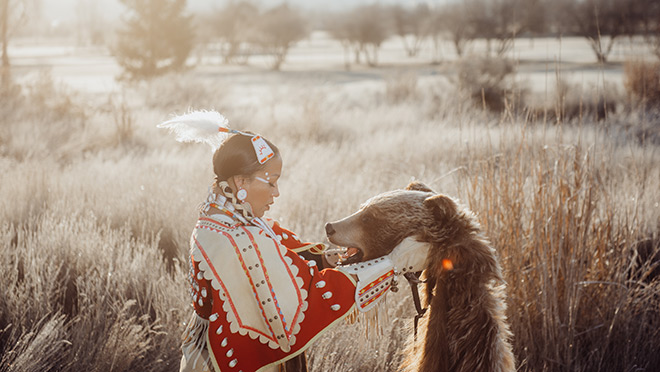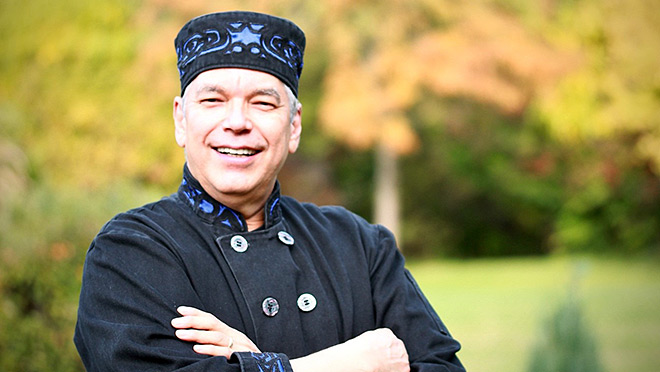Indigenous Survivors' Flag flies at BC Hydro main office

Emotional ceremony helps continue journey of reconciliation
As Nadine Israel spoke of just how powerful it was to see the newly-unveiled Survivors' Flag raised at BC Hydro headquarters, her emotions got the best of her. Wiping aside tears, she continued.
"It's a very personal journey for us," said Israel, who is from the Skeetchestn of the Secwepemc Nation in B.C.'s central interior and has been with BC Hydro since 2016. "I've only been with the company for a few years, but I think the conversations, the language and the openness, has really shifted to where we are today."
Israel is a member of RAIN, a BC Hydro employee network for Indigenous employees to come together to support one another and honour their ancestors, families, and culture, which led the flag raising ceremony. The ceremony was an opportunity to honour the Survivors and children impacted by Indian Residential Schools and share their Indigenous culture and history together and invite fellow employees to share in the experience.
"The flag will be flown for the next month," said BC Hydro's Wesley Lines, an electrical engineer who's a member of Yellowknives Dene First Nation. "It's our hope that everyone who sees the flag – everyone who works at BC Hydro and everyone who comes to visit – will take the time to reflect on the meaning behind it and how they can continue to support the ongoing work."
A crowd of employees gathered for the flag-raising the day before the 2022 National Day for Truth and Reconciliation – also known as Orange Shirt Day – on Friday, September 30. And while BC Hydro has hosted Orange Shirt Day events in the past, this one was steeped in Indigenous traditions.
The flag was carried by four BC Hydro employees, representing the north, south, east, and west. A Squamish Nation honour song was sung by two Squamish Nation members: Hereditary Chief Bill Williams and Willie Lewis. And there was a smudging ceremony, where medicines (sage and juniper) are burned to cleanse and to prepare people, ritual spaces, ceremonial tools, and objects.
The ceremony wrapped up with all gathering to reflect on the day over a snack of bannock.
Each September, and throughout the year, Canada's Indigenous communities reflect on the ongoing legacy of residential 'schools'. Children were not allowed to speak their traditional languages and were beaten if they did. They were malnourished, living in overcrowded conditions leading to frequent outbreaks of tuberculosis, and abused, in some cases to the point of death. Residential schools prioritized assimilation over education. And generations of children had their human rights violated simply for being Indigenous.
Israel hopes that in addition to acknowledging the Survivors, their families, and those who didn't survive, that we all take time to honour the resiliency of Indigenous communities.
"If we don't remember that we're more than trauma, we can be consumed," said Israel. " It's honouring the strength of who we are, and that every child matters. We're still here. I was just with my Granny, who just turned 98 and is a residential school survivor. She still lives at home, even if she doesn't get around as easily as before. When I think of her, there's a grace – and it's multiplied by thousands of families. It's about honouring all these families and communities."
Charlotte Mitha, BC Hydro's executive vice president of operations and sponsor of the RAIN Network, said she was honoured to be one of the four who carried the flag at the ceremony.
"The impact of residential schools is so painful and heartbreaking, but its our shared history and we stand together to raise this beautiful flag created with Survivors," said Mitha. "Its my strong belief that we all have a part to play in reconciliation, in learning and in making space for Indigenous teaching and ways of being."

What's in a flag? The Survivors' Flag explained
The commemorative Survivors' Flag is designed as an expression of remembrance, meant to honour residential school Survivors and all the lives and communities impacted by the residential school system in Canada.
Each element depicted on the flag was carefully selected by Survivors from across Canada, who were consulted in the flag's creation. Taking part in the flag's design were Inuit, Mi'kmaq, Atikamekw, Cree, Ojibway, Dakota, Mohawk, Dene, Nuu-chah-nulth, Secwepemc, and Métis Survivors.
Get a full understanding of the individual elements on the Survivors' Flag at nctr.ca. But here are the basic elements included:
- The Family, in the form of two adults representing either parents or ancestors.
- The Children. Two were included as often whole sibling groups were taken from their families.
- The Seeds Below the Ground, which represent the spirits of the children who never returned home.
- Tree of Peace, the Haudenosaunee symbol of how Nations were united and brought to peace.
- Cedar Branch, the sacred medicine that represents protection and healing, but also what is used by some Indigenous cultures when one enters the physical world and then again when they pass on to the next.
- Cosmic Symbolism, represented by the sun, moon, stars, and planets. The Sun represents the divine protection that ensure those who survived came home. The North Star is an important navigation guide for many Indigenous cultures.
- The Metis Sash (left, in circle at top), a prominent ceremonial regalia worn with pride. Certain colours of thread represent lives that were lost, while others signal connectedness as humans and resilience through trauma.
- The Eagle Feather (central, in circle at top) which represents that the Creator's spirit is among us. Its depicted pointing upwards, which mirrors how it is held when one speaks their Truth.
- The Inuksuit (right, in circle at top) used as navigational guides for Inuit people and a link to tradition.
Learn more through popular books and film
When asked for recommendations on ways for the general public to understand the impact residential schools had Indigenous communities, Israel and Lines recommended reading books and watching films where Indigenous peoples tell stories in their own words.
Electrical engineer Lines, who grew up in Ndilǫ, NT., recommends the documentary For Love (on Netflix Canada), a story of resilience that details the horrors of the past and reveals how Indigenous communities are taking back jurisdictional control of their children. He's also a fan of the documentary TV series First Contact (on APTN, Apple TV), which takes six Canadians on a 28-day journey designed to challenge their perceptions and to shed light on the true Indigenous experience.
Lines also suggested taking a beginner class in an Indigenous language, noting that from 2022 to 2032, the United Nations is promoting the International Decade of Indigenous Languages.
"Language loss is a tragic effect of residential schools," said Lines. "Since language is tied so intimately to culture and identity, it's important to ensure these languages survive and flourish. Indigenous language learning not only supports revitalization efforts, but also provides a unique insight into Indigenous culture. "
Israel recommends the books of late Ojibwe author Richard Wagamese, best known for the novel Indian Horse. The novel tells the story of a First Nations boy from Ontario who survives the residential school system and thrives as a hockey player, but who struggles as his past traumas resurface.
Michelle Good's Five Little Indians is a story closer to home, fictional but stirring in its tale of how five First Nations children are torn from their families, and after leaving residential schools, find their way on the streets of Vancouver's Downtown Eastside.
Also watch for the dramatic film Bones of Crows, the opening film of the 2022 Vancouver International Film Festival. It's a multi-generational tale of a Cree matriarch that's both an indictment of the residential schools system and a story of resilience and resistance.

